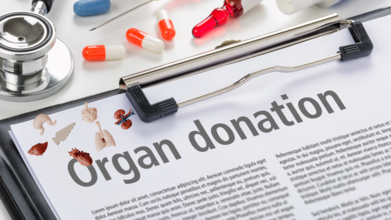- Health Conditions A-Z
- Health & Wellness
- Nutrition
- Fitness
- Health News
- Ayurveda
- Videos
- Medicine A-Z
- Parenting
- Web Stories
If You Are Scared Of Needles, Scientists May Have A 'Painless' Dental Solution For Your Next Vaccine

Credits: Canva
For decades, getting vaccinated has meant rolling up your sleeve, bracing for a quick jab, and hoping the soreness fades within a day. But a team of researchers may have just discovered a way to sidestep the needle entirely — by delivering vaccines through something as ordinary as dental floss.
The idea sounds almost too simple: coat floss or a floss pick with a vaccine, thread it between your teeth, and let your gums do the rest. But the science behind it is far from gimmicky. This novel approach targets a unique spot in the mouth called the junctional epithelium, an unusually permeable layer of tissue where the gums meet the teeth. And according to early research, this entry point could unlock stronger protection against respiratory infections — and for some people, make getting vaccinated a far less stressful experience.
Most viruses that wreak havoc on the body, including influenza and COVID-19, first invade through the mucosal surfaces of the mouth, nose, or lungs. Traditional injectable vaccines do an excellent job of generating antibodies in the bloodstream, but they’re less effective at producing antibodies along these mucosal barriers — the body’s first defense line.
Dr. Harvinder Singh Gill, a professor in nanomedicine at North Carolina State University and senior author of the study, explains the advantage: “When a vaccine is given via a mucosal surface, antibodies are stimulated not only in the bloodstream but also on mucosal surfaces. This improves the body’s ability to prevent infection, because there’s an additional line of defense before a pathogen even enters the body.”
That’s where the junctional epithelium comes in. Unlike most epithelial layers that are tightly sealed to keep invaders out, the JE is intentionally “leaky” so immune cells can patrol and defend against the constant barrage of oral bacteria. This leakiness is exactly what makes it an appealing vaccine delivery route.
To test the concept, researchers applied a peptide-based flu vaccine to unwaxed dental floss, then used it to floss the teeth of lab mice. The results were striking. The floss-based delivery triggered far higher antibody responses on mucosal surfaces than the current gold-standard oral method — placing a vaccine under the tongue.
In fact, the immune protection was comparable to delivering the same vaccine through the nasal cavity, which is widely considered the most effective mucosal route. The big difference? Nasal vaccination comes with safety concerns, including the rare but serious possibility that the vaccine could migrate to the brain. The floss technique avoids that risk entirely.
Lead author Rohan Ingrole, who conducted the research during his doctoral studies at Texas Tech University, adds that the method also worked across multiple vaccine types — including protein-based vaccines, inactivated viruses, and mRNA formulations. In each case, the floss delivery triggered robust immune responses both in the bloodstream and across mucosal surfaces.
What Is the Junctional Epithelium?
The JE sits deep in the gum pocket, where it forms a protective seal between the tooth and surrounding gum tissue. Its structure lacks many of the tight junctions found in other mucosal linings, making it easier for molecules — including vaccine antigens — to cross. And because it’s already brimming with immune cells, any antigen that slips through is quickly flagged, sparking an immune reaction.
Delivering a vaccine here isn’t straightforward. The tissue is tucked away and can’t be reached with a simple swab or spray. Dental floss, however, is designed to slip into exactly that space — which is why it’s the perfect vehicle for the job.
Flossing Vaccine Shows Success In Early Human Trials
While full-scale human vaccine trials are still a way off, the researchers ran a smaller test to confirm whether people could successfully target the junctional epithelium using floss picks. They coated floss with fluorescent food dye and asked 27 volunteers to try to deposit the dye into their gum pockets. The results were encouraging: about 60% of the dye ended up exactly where it needed to be.
This success suggests that with the right design, floss picks could be a practical, self-administered vaccine delivery tool — potentially mailed to people’s homes in the future.
Needle-free vaccination is more than just a comfort perk. Globally, needle phobia is a significant barrier to vaccine uptake, even among adults. There’s also the risk of unsafe injection practices, which can transmit blood-borne diseases in settings without strict medical oversight.
A floss-based vaccine could address several of these challenges. It’s simple to administer, doesn’t require a healthcare professional, and could be distributed more easily in hard-to-reach areas. Storage and transport could also be simplified compared to injectable vaccines that require strict cold-chain logistics.
Dr. Gill notes another advantage: eating and drinking immediately after floss-based vaccination doesn’t appear to interfere with the immune response — at least in animal models. That flexibility could make it easier for people to incorporate vaccination into daily routines without major disruptions.
Are There Any Limitations to Such Vaccines?
Despite the promise, this approach isn’t without drawbacks. It wouldn’t work for infants or toddlers without teeth, and it may be less effective for people with gum disease or severe oral infections. Researchers also need to study how different oral health conditions could influence vaccine uptake and immune response.
For now, the team’s next step is to refine the delivery system and begin clinical safety trials. If successful, floss-based vaccines could become an alternative option for seasonal flu shots, pandemic preparedness, and even certain routine immunizations.
The floss vaccine fits into a growing push to move beyond injections. Researchers have explored dissolvable microneedle patches, inhalable vaccines, and even edible vaccine capsules. Each approach aims to make vaccination less invasive, easier to distribute, and more acceptable to populations hesitant about traditional methods.
In this case, the innovation comes from using a tool that people already know and can use on their own. The fact that it could also boost mucosal immunity something standard injections struggle to do — makes it even more compelling.
We’re still years away from picking up a vaccine-coated floss pick at the pharmacy, but the groundwork is being laid. If clinical trials confirm its safety and effectiveness, floss-based vaccination could offer a new, accessible, and needle-free way to protect against some of the world’s most common and dangerous infections.
World Organ Donation Day 2025: Theme, History, And Importance

Credits: Canva
Every year, on August 13, World Organ Donation Day is observed, globally, to spread awareness about the importance of organ donation and to make people aware about the misconceptions that surround organ donation.
World Organ Donation Day 2025 Theme And Significance
This year's theme for World Organ Donation Day is 'Answering the Call'. This theme highlights the important function played by the professionals in the organ donation community. What it means is to encourage more to strengthen their dedication to save as many lives as possible through organ donation and transplantation.
The Pace Hospital notes that as of 2021, globally, 1,44,302 organ transplantations had occurred, of which, 26.44% were of deceased organ donation. India performed a total of 12,259 transplantation, contributing to 8% in global transplantations. In India, the most transplants that took place were for kidneys at 74.27%, liver at 23.33%, heart at 1.23%, lung at 1.08%, pancreas at 0.15%, and small intestine at 0.03%.
The overall number of deceased donors transplantation in India was 4.5%. While the deceased donors transplantation in India was reported 759 for kidney, 279 for liver and 99 for heart, the Indian Ministry of Health's estimated that it needs 175,000 kidneys, 50,000 livers, hearts, and lungs and 2,500 pancreas to meet the demand.
The Indian Ministry of Road and Transport and Highway's 2021 report notes that more than 1.5 lakh were reported as accident-related mortalities, however, only 552 deceased brain deaths organ transplantations took place in 2021. This is why it is more so important to raise awareness about organ donation to help those in requirement and reducing the number of patients on the waiting list.
History Of Organ Donation
It was in 1954, when the first successful organ transplant was performed. It was a kidney transplant by Dr Joseph Murray and his team at Peter Bent Brigham Hospital in Boston, Massachusetts.
The donor was Ronald Lee Herrick, who donated his organ to his twin brother Richard Herrick. Later in 1990, the doctor was honored with Nobel Prize in Physiology and Medicine for bringing advances in organ transplantation.
Th United Network for Organ Sharing (UNOS) highlights the timeline of the first donations and transplants performed of different organs.
- 1996: First simultaneous kidney and pancreas transplant performed.
- 1967: First successful liver transplant performed.
- 1968: The Southeast Organ Procurement Foundation implemented the first computer-based organ matching system, which was dubbed as UNOS. It successfully performed the first isolated pancreas transplant and heart transplant.
- 1981: First successful heart-lung transplant performed.
- 1983: First successful single-lung transplant performed. Cyclosporine, the first of a number of drugs that effectively treat organ rejection by suppressing the human immune system, introduced.
- 1984: National Organ Transplant Act (NOTA) was passed.
- 1986: First successful double-lung transplant performed.
- 1987: First successful intestinal transplant performed.
- 1988: First split-liver transplant performed.
- 1989: First successful living donor liver transplant performed.
- 1990: First successful living donor lung transplant performed.
- 1992: UNOS helped found Donate Life America to build public support for organ donation.
- 1998: First successful adult-to-adult living donor liver transplant performed.
How Organ Donation Can Change A Life?
In March 2024, a dedicated Delhi-based teacher, Meena Mehta was declared brain dead and her organs were donated to many, including her hands, shared her nephew Jawed Mehta. A 45-year-old Delhi-based painter had lost both his hands in a 2020 train accident, who received hand transplant. The hands were of Meena Mehta. After a 12-hour long surgery, the painter was able to paint again. Meena Mehta also donated her kidney, liver, and corneas, which has changed lives of three more people.
Monica Seles Says She Was Relieved With The Myasthenia Gravis Diagnosis, But It Has Changed Her Life

Credits: Wikimedia Commons
Nine-time Grand Slam champion Monica Seles is using her popularity and platform to shed light on a rare chronic neuromuscular condition that has changed her life. Myasthenia Gravis.
In an interview with Good Morning America on Tuesday, the former World No. 1 revealed for the first time that she was diagnosed three years ago with myasthenia gravis, or MG, an autoimmune disease that causes muscle weakness.
"It was 30 years ago that I came back to the [U.S.] Open ... It was like a reset, and this was one of the reasons I decided to go public with my myasthenia gravis," Seles said. "It’s been a huge reset not just in my professional life as a tennis player, but also in my personal life."
Seles, who last played professionally in 2003 and officially retired in 2008, said she hopes her story will help others who may be struggling with unexplained symptoms.
Recognizing the Signs
The 51-year-old said her training as a professional athlete helped her notice early changes in her body.
"I started experiencing these symptoms of extreme leg weakness, arm weakness, double vision. So I realized, ‘This is very unusual,’" she explained. "Once I was diagnosed, it was like a relief, but also it was a challenge."
Travel, once routine during her tennis career, has become more complicated. "Even coming here today, in the old days, traveling would be a no-brainer. Now I had to get packing tips. I had to learn a new way to live with MG," she said.
Speaking Out to Help Others
Seles admitted she had never heard of myasthenia gravis before her diagnosis. "I had no clue what it was. I had a hard time pronouncing it," she said with a smile.
She hopes that talking about her experience will encourage people to seek medical advice if they notice changes in their health.
"It’s been a very challenging time dealing with it," she added. "But knowing there’s hope out there and a great community has helped me tremendously."
Her message to others: "Advocate for yourself and know your symptoms."
Also Read: Tennis Player Monica Seles Opens Up About Her Myasthenia Gravis Diagnosis
What Is Myasthenia Gravis?
According to the U.S. National Institute of Neurological Disorders and Stroke (NINDS), myasthenia gravis is a chronic neuromuscular disease that causes weakness in voluntary muscles, the muscles responsible for movements like walking, swallowing, breathing, and facial expressions.
MG occurs when the immune system mistakenly attacks healthy muscle receptors, disrupting the signals needed for muscle contraction. Johns Hopkins Medicine notes that the condition is not inherited or contagious and often develops later in life.
The disease can affect anyone, but it most commonly impacts women under 40 and men over 60. Symptoms may include:
- Drooping eyelids (ptosis) and double vision (diplopia)
- Muscle weakness that worsens with activity
- Trouble swallowing or speaking clearly
- Weakness in the arms, legs, neck, or face
- Shortness of breath in severe cases
Symptoms can vary widely between individuals. In rare situations, a myasthenic crisis may occur, affecting breathing muscles and requiring emergency medical care.
Diagnosis and Treatment
Because the symptoms of MG can resemble other health conditions, diagnosis involves a combination of physical and neurological exams, blood tests, and nerve stimulation studies.
There is currently no cure, but treatments can help manage symptoms and improve quality of life. These may include medications that enhance communication between nerves and muscles, immunosuppressive drugs, and in some cases, surgery to remove the thymus gland.
Temporary forms of MG can occur in newborns if a mother has the disease, but these cases usually resolve within two to three months.
Looking Ahead
While managing myasthenia gravis has brought challenges, Seles continues to find joy in life and in the sport she loves. She still follows tennis closely and is excited about the current generation of players.
"I wish I had a crystal ball," she said. "I love Coco Gauff, the electricity she brought to the U.S. Open. As a tennis fan, we just want great matches and the excitement of the fans."
By sharing her personal journey, Seles hopes to break the silence around MG and help others feel less alone. "When I got diagnosed, I wished I had heard someone talk about it. Now, I hope my story can be that for someone else."
Breakthrough Vaccine Could Stop Pancreatic Cancer From Returning- Here Are 6 Signs of The Deadly Disease

Credits: Health and me
Pancreatic cancer has long been one of the toughest challenges in oncology. With a five-year survival rate hovering around 13% and recurrence rates approaching 80% after treatment, the odds have historically been stacked against patients. Now, a new vaccine targeting a common cancer mutation may change that outlook and potentially save lives.
The experimental treatment, known as ELI-002 2P, has shown early promise in preventing aggressive pancreatic cancers from returning, according to findings published in Nature Medicine.
Part of the problem lies in timing. Pancreatic cancer symptoms are notoriously vague, often mimicking less serious conditions like gallstones or irritable bowel syndrome. This means many patients are diagnosed too late for surgery — the only potentially curative treatment.
Even for those lucky enough to undergo surgery and chemotherapy, microscopic cancer cells can remain in the body, lying in wait to trigger recurrence. These “invisible” cells can’t be detected on scans, but they can be identified through blood tests that pick up tumor DNA.
The ELI-002 2P vaccine is designed to target mutations in the KRAS gene, which is present in up to 90% of pancreatic cancers and about 40% of colon cancers. Historically, KRAS mutations were considered “undruggable” because the mutated proteins resemble normal ones so closely that the immune system ignores them.
The new vaccine sidesteps this problem by training the immune system to recognize these subtle differences. Using small chains of amino acids called peptides, the vaccine teaches T-cells the immune system’s attack force to find and destroy KRAS-mutated cells.
How the Pancreatic Cancer Vaccine Works?
Unlike personalized cancer vaccines that require sequencing each patient’s tumor, ELI-002 2P is “off-the-shelf.” This means it can be manufactured in bulk, speeding up access and lowering costs.
The vaccine also includes a special “tail” that helps the peptides stay longer in lymph nodes — where immune cells are activated — increasing the chance of a strong immune response.
The Phase 1 study enrolled 25 patients: 20 with pancreatic cancer and 5 with colon cancer. All had undergone surgery and chemotherapy but still had cancer DNA in their blood. Patients received up to six priming doses of the vaccine over several months, with 13 participants also receiving booster shots. The results were striking:
- 85% mounted an immune response to the KRAS mutations.
- Two-thirds had a strong enough response to clear lingering cancer cells.
- Nearly 70% developed immunity to other tumor targets not included in the vaccine.
In pancreatic cancer patients, the average survival was 29 months, with more than 15 months free from recurrence.
A handful of “super-responders” patients whose immune systems reacted exceptionally well enjoyed the best survival outcomes. Researchers noted that the strongest immune responses correlated with the longest recurrence-free periods, suggesting the vaccine directly contributed to these results.
Dr. Zev Wainberg, co-director of UCLA’s gastrointestinal oncology program, emphasized the urgency:
“If you were to ask me what disease most needs something to prevent recurrences, I’d say this one.”
Why This Could Be a Turning Point for Cancer Vaccines?
Cancer vaccines have a checkered history. The challenge lies in finding targets unique enough to cancer cells without harming healthy tissue. Advances in mRNA technology, faster genetic sequencing, and novel peptide designs are beginning to crack that code.
This KRAS-targeted vaccine offers a proof-of-concept that such approaches can work even against aggressive, mutation-driven cancers.
The promising early results have already led to a Phase 2 trial, comparing the vaccine against standard post-surgery care. If larger studies confirm the findings, ELI-002 2P could become a powerful addition to the pancreatic cancer treatment arsenal — and potentially extend to other KRAS-driven cancers.
Stephanie Dougan, an associate professor at Dana-Farber Cancer Institute, called the work “really exciting,” noting, “The fact that the long-term survival really correlated with T-cell response suggests that the vaccine caused this.”
Silent Warning Signs of Pancreatic Cancer
While this breakthrough offers hope, prevention and early detection remain vital. Experts warn that pancreatic cancer often masquerades as common ailments, delaying diagnosis. Here are some early symptoms that should never be ignored:
- Abdominal or back pain that worsens over time or eases when leaning forward.
- Unexplained weight loss without changes in diet or exercise.
- Jaundice, including yellowing of the eyes and skin, sometimes with intense itching.
- Changes to urine or stool, such as dark urine or pale, greasy stools.
- New-onset diabetes without obvious risk factors.
- Persistent fatigue unrelated to poor sleep or lifestyle.
These symptoms often appear in combination and warrant immediate medical attention — particularly for those with a family history of pancreatic cancer.
Pancreatic cancer has long been a grim diagnosis, but research like this signals a shift in momentum. An “off-the-shelf” vaccine that primes the immune system to attack one of cancer’s most notorious mutations could fundamentally change how doctors manage post-surgical treatment.
While the journey from early trial to approved therapy is long, the potential impact is hard to overstate. For patients facing one of the toughest cancers known to medicine, ELI-002 2P could one day mean the difference between a brief remission and a lasting cure.
© 2024 Bennett, Coleman & Company Limited

